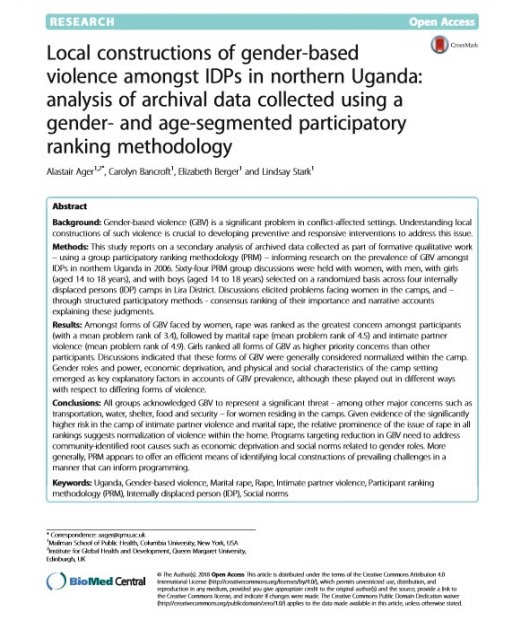When developing interventions aimed at preventing and responding to Gender Based Violence (GBV), having a context-specific understanding of constructions of GBV is key. This article, published in BMC Conflict and Health reports on a secondary analysis of archived data collected as part of formative qualitative work – using a group participatory ranking methodology (PRM) – informing research on the prevalence of GBV amongst internally displaced people (IDPs) in four camps in northern Uganda in 2006. This participatory research aimed to unpack local construction of GBV experienced by camp residents, explicitly seeking the understandings not only of women but also of men and, acknowledging the potential of perceived norms in shaping future behavior, of girls and boys. Structured participatory methods yielded candid conversation on the overall risk environment and specific problems they face, consensus ranking of the importance of each problem, and personal narratives explaining these judgements. GBV was acknowledged as a significant threat, and PRM appears to offer an efficient means of identifying local constructions of prevailing challenges in a manner that can inform programming.
The findings revealed that within the range of GBV concerns mentioned by women participants, rape was ranked as the greatest concern amongst participants (with a mean problem rank of 3.4), followed by marital rape (mean problem rank of 4.5) and intimate partner violence (mean problem rank of 4.9). Girls ranked all forms of GBV as higher priority concerns than other participants. Discussions indicated that these forms of GBV were considered largely as “norms” within the camps. In explaining GBV prevalence and normalization, participants discussed gender roles and power disparities, economic deprivation, and physical and social characteristics of the camp setting as enabling factors; however, these played out in different ways with respect to differing forms of violence.
The PRM analysis results provide important recommendations for tailoring interventions to meet the specific needs of residents of the camp rather than “one-size fits all” GBV interventions. In this case, provided the evidence of the significantly higher risk in the camp of intimate partner violence and marital rape and the suggestion of normalization of violence within the home, there was a need for programming directed at shifting attitudes and behavior around IPV within the household unit. Simultaneously, programs targeting reduction in GBV need to address community-identified root causes such as economic deprivation and social norms related to gender roles, which may involve a wide range of stakeholders across sectors. More generally, PRM appears to offer an efficient means of identifying local constructions of prevailing threats and risks which can enable more appropriate and effective responses to protection issues.
Read the article here.
